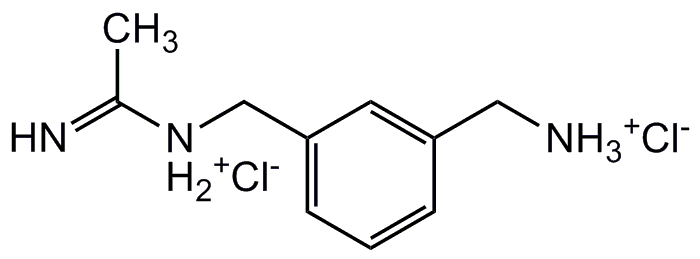1400W . dihydrochloride
| Code | Size | Price |
|---|
| AG-CR1-0018-M005 | 5 mg | £45.00 |
Quantity:
| AG-CR1-0018-M025 | 25 mg | £150.00 |
Quantity:
| AG-CR1-0018-M100 | 100 mg | £430.00 |
Quantity:
Prices exclude any Taxes / VAT
Overview
Regulatory Status: RUO
Shipping:
Ambient
Storage:
4°C
Images
Documents
Further Information
Alternate Names/Synonyms:
N-(3-(Aminomethyl)benzyl)acetamidine . 2HCl
Appearance:
White to off-white solid.
CAS:
214358-33-5
EClass:
32160000
Form (Short):
liquid
Handling Advice:
Hygroscopic.
InChi:
InChI=1S/C10H15N3.2ClH/c1-8(12)13-7-10-4-2-3-9(5-10)6-11;;/h2-5H,6-7,11H2,1H3,(H2,12,13);2*1H
InChiKey:
WDJHSQZCZGPGAA-UHFFFAOYSA-N
Long Description:
Chemical. CAS: 214358-33-5. Formula: C10H15N3 . 2HCl. MW: 177.3 . 72.9. A slow, tight binding and highly selective inhibitor of iNOS (inducible nitric oxide synthase/NOS II) (Kd < 7 nM). Weak and reversible inhibition of nNOS (neuronal nitric oxide synthase/NOS I) (Ki < 2) and eNOS (endothelial nitric oxide synthase/NOS III) (Ki < 50 µM). Inhibits tumor growth. Increases vasoconstriction to noradrenaline. Improves contractile function. Improves stroke outcome and decreases glutamate release. Anti-inflammatory. Review.
MDL:
MFCD03428622
Molecular Formula:
C10H15N3 . 2HCl
Molecular Weight:
177.3 . 72.9
Package Type:
Vial
Product Description:
A slow, tight binding and highly selective inhibitor of iNOS (inducible nitric oxide synthase/NOS II) (Kd < 7 nM) [1, 3, 4, 6]. Weak and reversible inhibition of nNOS (neuronal nitric oxide synthase/NOS I) (Ki < 2) and eNOS (endothelial nitric oxide synthase/NOS III) (Ki < 50 µM) [1]. Inhibits tumor growth [2]. Increases vasoconstriction to noradrenaline [7]. Improves contractile function [8]. Improves stroke outcome and decreases glutamate release [9]. Anti-inflammatory [10]. Significant AMPK activity suppressor. Review [5].
Purity:
>98% (NMR)
SMILES:
[Cl-].[Cl-].CC(=N)[NH2+]CC1=CC=CC(C[NH3+])=C1
Solubility Chemicals:
Soluble in water, methanol or DMSO.
Transportation:
Non-hazardous
UNSPSC Category:
Biochemical Reagents
UNSPSC Number:
12352200
Use & Stability:
Stable for at least 2 years after receipt when stored at +4°C.
References
1400W is a slow, tight binding, and highly selective inhibitor of inducible nitric-oxide synthase in vitro and in vivo: E.P. Garvey, et al.; J. Biol. Chem. 272, 4959 (1997) | Selective inhibition of inducible nitric oxide synthase inhibits tumor growth in vivo: studies with 1400W, a novel inhibitor: L.L. Thomsen, et al.; Cancer Res. 57, 3300 (1997) | Actions of isoform-selective and non-selective nitric oxide synthase inhibitors on endotoxin-induced vascular leakage in rat colon: F. Laszlo & B.J.R. Whittle; Eur. J. Pharmacol. 334, 99 (1997) | The inhibitory potency and selectivity of arginine substrate site nitric-oxide synthase inhibitors is solely determined by their affinity toward the different isoenzymes: R. Boer, et al.; Mol. Pharmacol. 58, 1026 (2000) | Nitric oxide synthases: structure, function and inhibition: W.K. Alderton, et al.; Biochem. J. 357, 593 (2001) | Structural basis for the specificity of the nitric-oxide synthase inhibitors W1400 and Nomega-propyl-L-Arg for the inducible and neuronal isoforms: R. Fedorov, et al.; J. Biol. Chem. 278, 45818 (2003) | Increased vasoconstriction to noradrenaline by 1400W, inhibitor of iNOS, in rats with streptozotocin-induced diabetes: X. Cheng & C.C. Pang; Eur. J. Pharmacol. 484, 263 (2004) | Inhibition of iNOS with 1400W improves contractile function and alters nos gene and protein expression in reperfused skeletal muscle: P. Patel, et al.; Microsurgery 24, 324 (2004) | Inhibition of iNOS activity by 1400W decreases glutamate release and ameliorates stroke outcome after experimental ischemia: F.J. Perez-Asensio, et al.; Neurobiol. Dis. 18, 375 (2005) | Selective iNOS inhibitor 1400W enhances anti-catabolic IL-10 and reduces destructive MMP-10 in OA cartilage. Survey of the effects of 1400W on inflammatory mediators produced by OA cartilage as detected by protein antibody array: K. J?rvinen, et al.; Clin. Exp. Rheumatol. 26, 275 (2008) | Glucose Metabolism and AMPK Signaling Regulate Dopaminergic Cell Death Induced by Gene (alpha-Synuclein)-Environment (Paraquat) Interactions: A. Anandhan, et al.; Mol. Neurobiol. 54, 3825 (2017)



